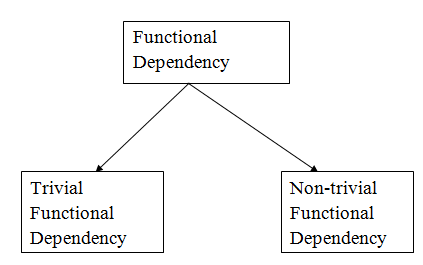Functional Dependency
The functional dependency is a relationship that exists between two attributes. It typically exists between the primary key and non-key attribute within a table.
X → Y
The left side of FD is known as a determinant, the right side of the production is known as a dependent.
For example:
Assume we have an employee table with attributes: Emp_Id, Emp_Name, Emp_Address.
Here Emp_Id attribute can uniquely identify the Emp_Name attribute of employee table because if we know the Emp_Id, we can tell that employee name associated with it.
Functional dependency can be written as:
Emp_Id → Emp_Name
We can say that Emp_Name is functionally dependent on Emp_Id.
Types of Functional dependency

1. Trivial functional dependency
- A → B has trivial functional dependency if B is a subset of A.
- The following dependencies are also trivial like: A → A, B → B
Example:
Consider a table with two columns Employee_Id and Employee_Name.
{Employee_id, Employee_Name} → Employee_Id is a trivial functional dependency as
Employee_Id is a subset of {Employee_Id, Employee_Name}.
Also, Employee_Id → Employee_Id and Employee_Name → Employee_Name are trivial dependencies too.
2. Non-trivial functional dependency
- A → B has a non-trivial functional dependency if B is not a subset of A.
- When A intersection B is NULL, then A → B is called as complete non-trivial.
Example:
ID → Name,
Name → DOB




No comments:
Post a Comment